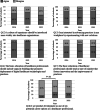The Evolution of Medical Student Competencies and Attitudes in Digital Health between 2016-2022: A Comparative Cross-Sectional Study
- PMID: 40386834
- PMCID: PMC12313084
- DOI: 10.2196/67423
The Evolution of Medical Student Competencies and Attitudes in Digital Health between 2016-2022: A Comparative Cross-Sectional Study
Abstract
Background: Modern healthcare systems worldwide are facing challenges, and digitalization is viewed as a way to strengthen healthcare globally. As healthcare systems become more digital, it's essential to assess healthcare professionals' competencies and skills to ensure they can adapt to new practices, policies, and workflows effectively.
Objective: The aim of this study was to analyse how the attitudes, skills and knowledge of medical student concerning digital health have shifted from 2016 to 2022 in connection with the development of the national healthcare information system architecture utilising the Clinical Adoption Meta-Model framework.
Methods: The study population consisted of fifth-year medical students from one University in Finland during 2016, 2021 and 2022. A survey questionnaire was administered comprising seven background questions and 16 statements rated on a five-point Likert scale assessing students' attitudes towards digital health and their self-perceived digital capabilities. The results were recategorized into a dichotomous scale. The statistical analysis employed Pearson's chi-square test. The Benjamini-Hochberg procedure was used for multiple variable correction.
Results: The study included 215 medical students (n = 45 in 2016, n = 106 in 2021, and n = 64 in 2022) with an overall response rate of 53% (43% in 2016, 74% in 2021, and 42% in 2022). Throughout 2016, 2021, and 2022, medical students maintained positive attitudes towards using patient-generated information and digital applications in patient care. Their self-perceived knowledge of the national patient portal significantly improved, with agreement increasing by 35 percentage points from 2016 to 2021 (P<.001) and this trend continued in 2022 (P<.001). However, their perceived skills in using electronic medical records did not show significant changes. Additionally, students' perceptions of the impact of digitalization on health promotion improved markedly from 2016 to 2021 (with agreement rising from 53% to 78%, P=.002) but declined notably again by 2022.
Conclusions: Medical students' attitudes and self-perceived competencies have shifted over the years, potentially influenced by the national health information system architecture developments. However, these positive changes have not followed a completely linear trajectory. To address these gaps, educational institutions and policymakers should integrate more digital health topics into medical curricula and provide practical experience with digital technologies to keep professionals up-to-date with the evolving healthcare environment.
Conflict of interest statement
Figures





Similar articles
-
The Evolution of Medical Student Competencies and Attitudes in Digital Health Between 2016 and 2022: Comparative Cross-Sectional Study.JMIR Med Educ. 2025 Jul 31;11:e67423. doi: 10.2196/67423. JMIR Med Educ. 2025. PMID: 40743520
-
Community and hospital-based healthcare professionals perceptions of digital advance care planning for palliative and end-of-life care: a latent class analysis.Health Soc Care Deliv Res. 2025 Jun 25:1-22. doi: 10.3310/XCGE3294. Online ahead of print. Health Soc Care Deliv Res. 2025. PMID: 40580081
-
Sexual Harassment and Prevention Training.2024 Mar 29. In: StatPearls [Internet]. Treasure Island (FL): StatPearls Publishing; 2025 Jan–. 2024 Mar 29. In: StatPearls [Internet]. Treasure Island (FL): StatPearls Publishing; 2025 Jan–. PMID: 36508513 Free Books & Documents.
-
Health professionals' experience of teamwork education in acute hospital settings: a systematic review of qualitative literature.JBI Database System Rev Implement Rep. 2016 Apr;14(4):96-137. doi: 10.11124/JBISRIR-2016-1843. JBI Database System Rev Implement Rep. 2016. PMID: 27532314
-
The educational effects of portfolios on undergraduate student learning: a Best Evidence Medical Education (BEME) systematic review. BEME Guide No. 11.Med Teach. 2009 Apr;31(4):282-98. doi: 10.1080/01421590902889897. Med Teach. 2009. PMID: 19404891
References
-
- Communication from the Commission to the European Parliament, the Council, the European Economic and Social Committee and the Committee of the Regions on enabling the digital transformation of health and care in the Digital Single Market; empowering citizens and building a healthier society. European Commission; 2018. https://digital-strategy.ec.europa.eu/en/library/staff-working-document-... URL.
-
- Recommendations on Digital Interventions for Health System Strengthening - WHO Guideline. World Health Organization; 2019. [06-04-2025]. https://www.who.int/publications/i/item/9789241550505 URL. Accessed. ISBN.978- 92-4-155050-5 - PubMed
LinkOut - more resources
Full Text Sources
Research Materials

